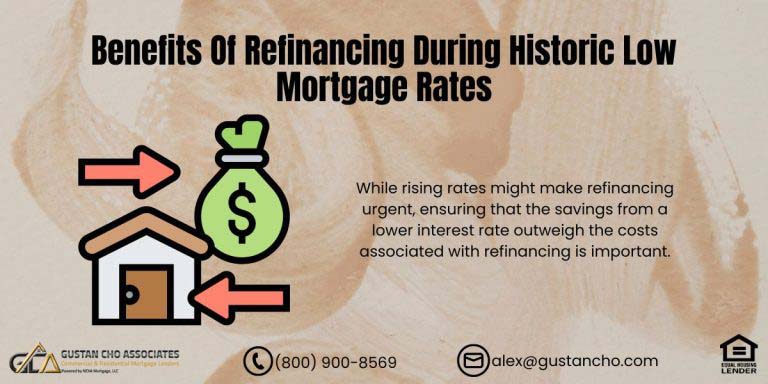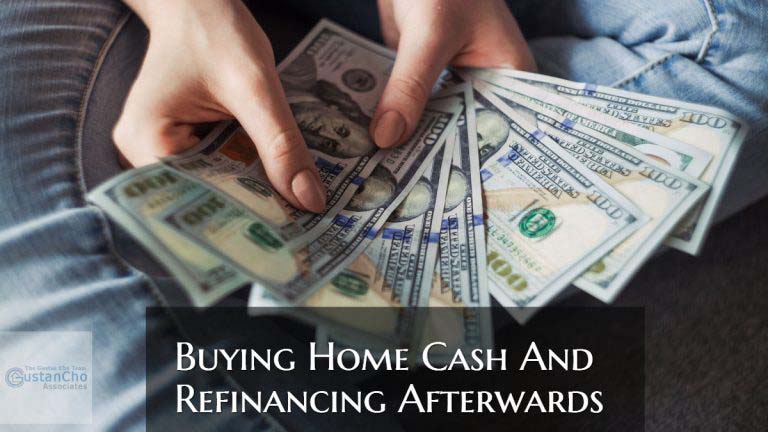This guide covers homeowners who should refinance now to save money. Par mortgage rates are hovering around 5.0% for prime borrowers. Mortgage rates are at a 23 month high. Prime borrowers are consumers with credit scores of at least 740 FICO and who have 20% down payment for a home purchase. John Strange, a senior loan officer at Gustan Cho Associates says the following about homeowners who should refinance now to save money:
Still, borrowers who are not prime borrowers can benefit from refinancing their current home loans for better mortgage rates. They can save tens of thousands over the course of their mortgage loan.
FHA, VA, and USDA loan mortgage rates also follow Fannie Mae and Freddie Mac’s mortgage rates. If conventional rates go up, so do mortgage rates on government loans. Government loans are loans that are FHA, VA, and USDA. There is a lot of talk of mortgage rates rising in the second half of 2025. However, if you are paying attention to mortgage rates and the volatility of mortgage rates in the past several weeks, you will see that all indicators seem like mortgage rates will be going up sooner than later. In the following paragraphs, we will cover homeowners who should refinance now to save money.
Homeowners Who Should Refinance Now to Save Money: A Simple Guide for 2025
Refinancing your mortgage can be smart if you want to pay less each month, get a lower interest rate, or change how long you’ll pay off the loan. As we head into 2025, some homeowners will save much more money if refinance. This post will help homeowners with non-qualified mortgages, people going through a divorce, and anyone whose mortgage rate is over 7%. We’ll explain how to tell if you qualify, what you could gain, and the steps to take so you can get the best deal the market offers today.
Refinance Your Mortgage and Save Big—Act Now!
Don’t wait—take advantage of today’s low rates and save money on your monthly payments.
Homeowners Who Should Refinance Now: Homeowners with Non-QM Loans
If you have a non-QM mortgage, you probably got it because your finances didn’t fit the standard guidelines. These loans often come with higher rates and less stable terms. You can refinance into a conventional mortgage that meets safe lending rules. The move could lower your rate, smooth out your monthly payments, and help you avoid future spikes. Gather pay stubs, bank statements, and tax returns so lenders can see your up-to-date situation.
Homeowners Who Should Refinance Now: Homeowners Going Through Divorce
Divorce brings a lot of change, and your home loan may now be part of the plan. If you or your ex-spouse will stay in the house, now is the time to refinance the mortgage into just one name. This will remove one person from the loan and can lower the monthly payment by switching from a joint loan to a single mortgage with lower rates. Work with a divorce attorney and a lender who knows how to handle these cases, and clearly understand how much Equity is in the home and how it will be split.
Homeowners with Rates Over 7%
Mortgage rates are still up, but if your existing loan is above 7%, refinancing could help. Even a small drop in your rate can save you hundreds each month. Check to see if you can get a rate at least 0.5% lower than what you have now. If your home has gained value, you may also be able to drop private mortgage insurance (PMI), which adds more savings. Use a rate calculator to run the numbers, and talk to lenders about options like no-closing-cost loans that can help you break even faster.
Next Steps: Take Action
- Check Your Credit: Make sure your score is strong enough for the best rates.
- If it’s low, pay down credit cards and correct errors on your report.
- Get a Loan Estimate: Contact at least three lenders for loan estimates.
- Compare rates, closing costs, and monthly payments side by side.
- Stay Patient: The right rate may take time to show up.
- If rates drop, move quickly to lock in the savings.
- Close and Save: Once you choose a loan, review the closing disclosure, ask questions, and complete the refinance.
- The sooner you close, the sooner you’ll enjoy a lower payment.
- Refinancing today can be a smart money move if you fit one of these situations.
- Evaluate your finances, talk to a lender, and watch how much you save each month.
- The right refinance can change your budget for the better in 2025.
- With interest rates normalizing in 2025, borrowers with non-QM loans could see even bigger monthly savings if they switch to loans that fit their income profile.
- Shorter loan terms, like 15 years, could also help some borrowers pay less interest, making them debt-free sooner.
- Plus, getting a fixed rate replaces the uncertainty of the adjustable version, adding peace of mind.
- Anyone in this situation should gather income documents and credit reports early to streamline the process and see the savings on the first statement.
Homeowners Who Should Refinance Now: Refine and Transition After Divorce
Divorce often means a spouse has to remove their name from the mortgage, leading to the need for a refinance. The great news in 2025 is that lower credit-scoring rates and debt-to-income allowances let homeowners execute this change without adding monthly strain. Suppose the spouse keeping the house also refinances to a fixed loan with a lower interest rate. In that case, they can take over the existing Equity and avoid the pitfalls of an adjustable-rate mortgage, which can panic someone on a tight budget.
Cost estimates, a title update, and proof of the finalized settlement should be on hand before contacting lenders, since organized docs can speed up the process and cut surprise closing costs.
Homeowners Who Should Refinance Now: Homeowners Facing High Interest Rates
If someone is still stuck on a mortgage signed at over 7%, 2025 is the year to reroute. Even a small drop—say to 6.5%—turns a $300,000 mortgage into a $1,000 a month instead of $1,100, giving the budget some breathing room. FHA streamline and VA interest-rate-reduction loans can help qualified buyers skip the appraisal, keeping costs low.
Before locking in, people should test who beats their existing rate while scanning for hidden fees on lender loan estimates. Running a break-even calculator can also help decide how long they need to stay in the house to see the savings.
Make 2025 Your Year of Savings
Refinancing in 2025 is not a one-size-fits-all answer, but targeted borrowers can make their mortgage fit their lives better. From non-QM, through divorce, to escaping high rates, there is a clear playbook to cut monthly costs, lower stress, and build Equity faster.
Refinance Today and Lower Your Monthly Payments
Homeowners can save thousands by refinancing now—see if you qualify for lower rates.
Why You Should Think About Refinancing Your Non-QM Loan
Lower Interest Rates
Non-QM loans usually come with rates of 1 to 2% above those of conventional loans. Predictions for 2025 show mortgage rates landing around 5.5% to 6.5% for well-qualified borrowers. If you refinance now, you could shave a noticeable chunk off your monthly payment.
Better Loan Terms
Many non-QM loans have features that can surprise you, like prepayment penalties or changing rates. Moving to a fixed-rate conventional mortgage locks your payment in for the life of the loan, so you always know what to expect.
New Loan Options
If your situation has improved—maybe your credit score shot up or your income became more stable—you might now qualify for less expensive FHA, VA, or conventional loans.
Who Should Be Looking at This?
- Self-Employed Workers: If you had to take a Non-QM loan because traditional lenders didn’t see your income, but now you have solid, documentable earnings, it’s time to refinance.
- Better Credit Homeowners: If your credit score has climbed since you took the original Non-QM loan, lenders will see you as a lower risk and offer you a better deal.
- Balloon or ARM Borrowers: Refinancing is a smart way to remove that risk if a balloon payment is due soon or your adjustable rate is about to rise.
Next Steps: Homeowners Who Should Refinance Now To Save Money
- Check Your Credit First: If your score is between 620 and 680, you will likely qualify for a conventional or FHA loan.
- Gather Your Docs: Collect the paperwork lenders need—usually tax returns, bank statements, or other income documents—to prove you can carry a new loan.
- Shop for Lenders: No lender is the same, so compare your refinance options.
- Look for those with a solid track record in moving Non-QM borrowers to conventional mortgages.
These steps can now position you for lower rates, better terms, and more peace of mind.
Homeowners Post-Divorce: Refinancing to Remove a Spouse’s Name
Removing the ex-spouse’s name from the mortgage is a common task when a marriage ends. Refinancing the loan is usually the best way to do this. It simplifies ownership and can lower monthly payments.
Why Should You Refinance After a Divorce?
- Clear Title and Liability: Refinancing clears the ex-spouse’s name from the mortgage.
- This protects the spouse staying in the home from any future financial liability tied to the loan.
- Better Rates: If the old mortgage had a high rate of 7% or more, rates may drop in 2025.
- Refinancing to a lower rate can reduce monthly payments.
- Cash-Out Option: A cash-out refinance lets the homeowner tap Equity to pay off divorce-related costs such as alimony or a property settlement.
Challenges to Consider
- Qualifying on Your Own: After a divorce, the remaining homeowner must qualify based only on their income and credit.
- This can be a challenge without the ex-spouse’s financial strength.
- Legal Documents: The divorce decree should clearly state who is responsible for the mortgage.
- This helps avoid future arguments over payments.
- Closing Costs: Refinancing usually costs 2% to 5% of the loan amount.
- Before proceeding, consider these costs against the savings from a lower rate.
Next Steps
- Check the Divorce Decree: Read the divorce decree to confirm who is responsible for the mortgage and when the loan will be refinanced.
- Review Your Finances: Make sure your credit score and income can support a new loan without the ex-spouse’s name.
- A mortgage broker or lender can provide a pre-approval.
Homeowners with Rates Above 7%: Act Now
If your mortgage rate is still above 7%, refinancing in early 2025 might be your best bet. Experts predict rates will stabilize between 5.5% and 6.5% for borrowers with strong credit. Rates this high are leftover from loans taken in 2022 and 2023 that still lead to painful monthly bills.
Why Refinance Now?
- Monthly Savings: A drop from 7.5% to 6% on a $300,000 loan could reduce your monthly payment by more than $200.
- Long-Term Gain: Cutting just 1% from your rate might save you tens of thousands in interest over the life of a 30-year loan.
- Market Conditions: Changes like new tariffs and tax reforms can increase rates.
- Locking in a lower rate now can shield you from those future hikes.
Who Should Act?
- Homeowners who bought or refinanced during the high-rate years of 2022 and 2023.
- Anyone with a fixed-rate loan over 7% or an adjustable-rate mortgage (ARM) is about to reset.
- Borrowers who have boosted their credit score or gained Equity can now qualify for new, lower rates.
Action Steps
- Calculate Savings: Use a refinance calculator to see how your current payment compares to a new one.
- Boost Your Credit Score: Pay off debts and stay on time with bills to unlock better interest rates.
- Build Equity: If your home value has jumped, a higher equity stake (20% or more) can eliminate Private Mortgage Insurance (PMI).
- Shop Lenders: Get quotes from at least three different lenders to find the best rates and the lowest fees.
Key Considerations for Refinancing in 2025
Economic and Policy Factors
- Federal Reserve Moves: The recent pause in rate hikes means you may have a window to refinance before rates change again.
- Trump Administration Policies: Ongoing tariffs and tax cuts could nudge inflation and rates. A refinance in 2025 could catch a good trend.
- Market Dynamics: Strong housing demand and steady price growth can change your loan-to-value ratio and refinance eligibility.
Costs vs. Benefits
- Closing Costs: Plan on 2–5% of the new loan amount for fees.
- To see if the move pays off, find your break-even point.
- Example: $5,000 in fees and $200 in monthly savings means you’ll break even in 25 months.
- Loan Term: A longer term cuts your monthly payment but usually costs more in interest.
- A shorter term, like a 15-year loan, boosts your payment but saves on interest over time.
Eligibility Tips
- Credit Score: You should hit a 620 or higher for a conventional loan and 580 or higher for FHA loans.
- Debt-to-Income Ratio (DTI): Depending on the loan type, aim for a front-end DTI of under 28–31% and a total DTI of under 43–50%.
- Equity: Having at least 20% Equity in the home means avoiding private mortgage insurance (PMI) and usually getting better loan terms.
How to Get Started with Refinancing
- Assess Your Goals: Determine whether you want a lower monthly payment, a shorter loan term, or to take a co-borrower off the mortgage.
- Check Your Credit: I’d like you to get a free copy of your credit report.
- Fix any errors or clear up high balances.
- Gather Documents: You’ll need pay stubs, tax returns, bank statements, and any divorce decrees if they apply.
- Compare Lenders: Use online calculators or talk to mortgage brokers to hunt for the best rates and loan terms.
- Apply Promptly: Rates can change daily, so lock in a good rate as soon as you see it.
Ready to Refinance and Save on Your Mortgage?
Explore refinancing options and start saving money now with a better rate.
Move Quickly to Save More
If you have a non-QM loan, are going through divorce, or are stuck with a mortgage over 7%, refinancing in 2025 can lower your payments and boost your financial health. Know what you qualify for, compare multiple lenders, and take action fast. Lock in lower rates, score better loan terms, or remove an ex’s name from the title. This window won’t last, so don’t wait to improve your mortgage.
Are you thinking about refinancing? Contact a reliable lender or try an online rate comparison tool. In the comments, share your refinancing plans or stories to connect with others in your situation.
Refinancing your mortgage can save you much money if you do it right. If you’ve been in your loan for a while, a lower rate today can lead to lower monthly payments. That’s extra cash for bills, savings, or fun. Let’s examine why 2025 could be a smart time to refinance and how a non-QM refi can be a good option.
Why 2025?
The mortgage market is always changing. Experts think rates may drop slightly in 2025. If you already have a higher rate, waiting to refinance could mean even bigger savings. Keep an eye on market trends and your own financial goals to decide the best moment. If rates drop, being ready to refinance quickly could put money back in your pocket.
The Non-QM Advantage
Non-QM, or non-Qualified Mortgage loans, can be perfect for those with unique income situations. Maybe you’re self-employed, or you have income from rental properties. Traditional loans might not fit your profile, but a non-QM refi can. With options like bank statement income and asset depletion, these loans look at your whole story, not just a single number. Less paperwork and flexible terms can keep your monthly payments down.
The Bottom Line
Refinancing to save money in 2025 makes sense, especially with a non-QM loan if you have an income slice that’s hard to show. A good rate and flexible terms can put you in a better financial spot. Just run the numbers, check your credit, and talk with a lender to see how a refinance fits your payments and wallet.
Extreme Volatility Of Mortgage Rates
Mortgage rates have been extremely volatile Mortgage rates have skyrocketed in the early part of the week and dropped in the latter part of the week. Nobody can predict the future of mortgage rates but most agree that mortgage rates cannot remain this low forever.
Even with last week’s sudden spike in mortgage rates, mortgage rates are still at a 22 month high. Many homeowners who have been sitting on the sidelines waiting for mortgage rates to drop to prior to June 2013 levels may be missing out the chance of refinancing their current home loans.
Back in June 2023, tens of thousands of homeowners who were about to close on their refinance mortgage loans could not close due to the sudden rise in mortgage rates. Since they did not lock their mortgage rates, they lost the chance of refinancing their home loans since mortgage rates did not go through a correction after the sharp spike.
Freddie Mac 30 Year Mortgage Rates
Freddie Mac 30 year fixed mortgage rates are at 6.75% for prime borrowers which is a 0.78% basis point improvement from January 2025 mortgage rates. Freddie Mac’s 15 year fixed mortgage rates are still at recent lows with a 6.75% average for prime conventional borrowers. Refinancing at today’s rates may save homeowners with higher mortgage rates save tons of interest over the term of their mortgage loan.
The Types of Homeowners Who Should Refinance Now
Homeowners who have bought their homes prior to July 2017 should examine what interest rates they have and see what today’s rates are and see if they can benefit from a refinance mortgage. Also, homeowners who have an FHA insured mortgage loan should examine if they qualify for a conventional loan. They should see if they qualify for a conventional loan. Should explore the idea of refinancing their FHA loan to a conventional loan. This is either to reduce their monthly mortgage insurance or eliminate their mortgage insurance altogether.
Mortgage Homeowners Who Should Refinance Now With Cash-Out Mortgage
Real estate values have been going up since 2010 in most parts of the country, especially in California. Homeowners who purchased their homes several years ago should see what their property is worth by checking similar properties that have sold in their area.
Many California homeowners do not realize that their properties have gone up double digits. Same with homeowners in Florida and Illinois. Many homebuyers in certain states got lucky. Or priced their home purchases at the right time right after the real estate collapse of 2008.
They purchased their homes at the bottom of the housing market. Homeowners with substantial equity due to the appreciation of their home can qualify for a cash-out refinance mortgage. They can take cash out from their refinance mortgage and pay off other debts such as high-interest credit card balances, auto loans, installment loans, or use it for home improvements, or other investment. You are allowed up to an 80% loan to value on conventional loan cash-out refinance. HUD allows up to 80% on a cash-out FHA loan refinance mortgage. VA allows up to 100% on a cash-out refinance mortgage.
Homeowners Who Should Refinance Now To Save Money FAQs
When is the best time to refinance in 2025?
- Refinance when mortgage rates drop below your current rate (under 7%) and you plan to stay home long enough to pay closing costs.
Can I Refinance a Non-QM Loan into a Conventional Loan?
- Yes, you can.
- If your credit score, income, and debt-to-income ratio (DTI) meet conventional guidelines—usually a score of 620 or higher and a DTI of 43% or lower—then you may qualify to convert a non-QM loan into a conventional option.
How Does Divorce Impact Refinancing?
- After a divorce, the borrower staying in the house must independently qualify for the new loan.
- If debts need to be paid, you can do a cash-out refinance to remove Equity from the house and settle those financial obligations.
How Much Can I Save Refinancing a 7.5% Rate?
- If you refinance a $300,000 loan from 7.5% to 6%, you save around $200 monthly and about $72,000 over 30 years.
Refinance Now and Keep More Money in Your Pocket
Homeowners who refinance now could save big over the life of the loan—don’t miss out.










